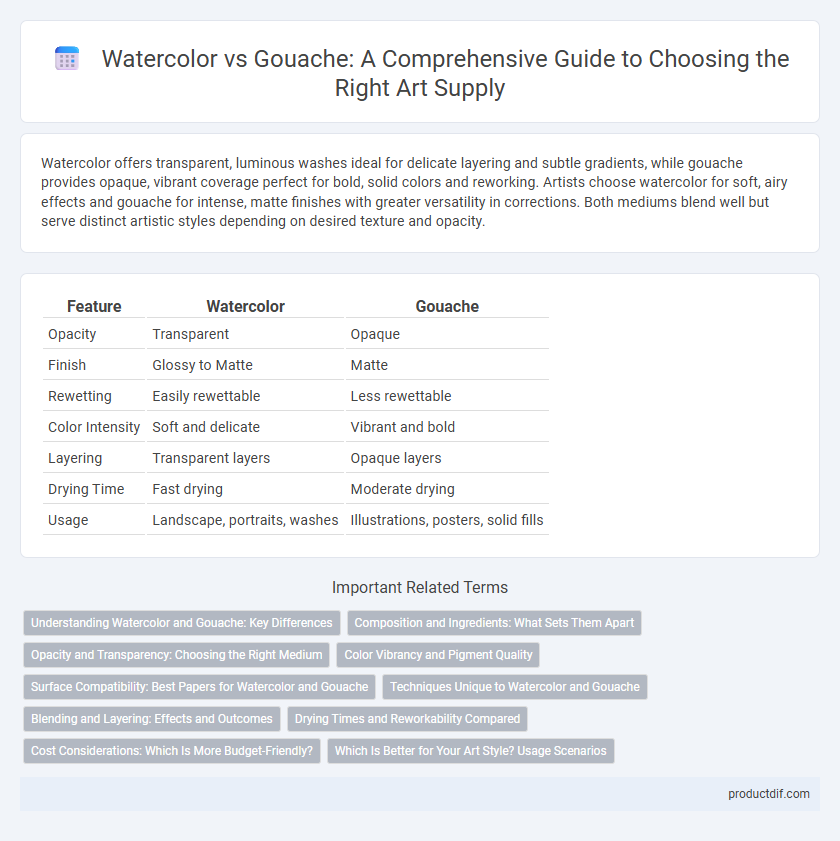Watercolor offers transparent, luminous washes ideal for delicate layering and subtle gradients, while gouache provides opaque, vibrant coverage perfect for bold, solid colors and reworking. Artists choose watercolor for soft, airy effects and gouache for intense, matte finishes with greater versatility in corrections. Both mediums blend well but serve distinct artistic styles depending on desired texture and opacity.
Table of Comparison
| Feature | Watercolor | Gouache |
|---|---|---|
| Opacity | Transparent | Opaque |
| Finish | Glossy to Matte | Matte |
| Rewetting | Easily rewettable | Less rewettable |
| Color Intensity | Soft and delicate | Vibrant and bold |
| Layering | Transparent layers | Opaque layers |
| Drying Time | Fast drying | Moderate drying |
| Usage | Landscape, portraits, washes | Illustrations, posters, solid fills |
Understanding Watercolor and Gouache: Key Differences
Watercolor is a translucent medium that allows light to pass through, creating delicate washes and subtle color variations, while gouache is an opaque paint that provides solid, vibrant coverage with a matte finish. Watercolor's transparency highlights paper texture and layering techniques, whereas gouache offers more control for bold, flat areas of color and easy correction. Artists choose watercolor for luminosity and blending, and gouache for vividness and versatility in mixed media.
Composition and Ingredients: What Sets Them Apart
Watercolor paint consists of pigment suspended in a water-soluble binder like gum arabic, producing a transparent and luminous finish. Gouache contains a higher concentration of pigment mixed with an opaque white filler such as chalk, creating a matte and more opaque surface. The chemical composition of gouache allows for better coverage and layering, while watercolor's formulation emphasizes translucency and fluid blending.
Opacity and Transparency: Choosing the Right Medium
Watercolor offers transparency that allows light to reflect off the paper, creating luminous effects ideal for layering and subtle gradients. Gouache provides higher opacity, enabling solid color coverage and bold, vibrant finishes suitable for graphic and illustrative work. Selecting between watercolor and gouache depends on whether the desired outcome emphasizes delicate translucency or dense, matte color.
Color Vibrancy and Pigment Quality
Watercolor paints offer transparent color vibrancy, allowing light to reflect through pigment layers for luminous effects, while gouache provides opaque, matte finishes with richer, more saturated color intensity due to higher pigment concentration. The pigment quality in gouache tends to be denser, delivering solid coverage ideal for bold designs, whereas watercolor pigments excel in subtle gradations and blending techniques. Artists choose between them based on desired visual impact, with gouache favoring vibrant, flat color blocks and watercolor emphasizing delicate, translucent washes.
Surface Compatibility: Best Papers for Watercolor and Gouache
Watercolor and gouache both perform best on heavyweight, textured papers specifically designed for wet media, such as cold-pressed or rough cotton rag papers with a weight of at least 300gsm. Watercolor paper's absorbent surface allows for smooth pigment blending and transparent washes, while gouache benefits from the same texture but requires a more robust surface to hold its opaque layers without warping. Papers like Arches, Fabriano Artistico, and Saunders Waterford are top choices, offering durability and optimal absorbency for vibrant, consistent results with both mediums.
Techniques Unique to Watercolor and Gouache
Watercolor techniques emphasize transparency and layering, allowing for delicate washes and subtle color gradations achieved through wet-on-wet and glazing methods. Gouache techniques utilize its opaque quality for solid, vibrant coverage and quick corrections, enabling artists to paint in layers without losing underlying colors. Both mediums require distinct brush control and mixing approaches to exploit their unique properties for texture and detail.
Blending and Layering: Effects and Outcomes
Watercolor offers translucent layering that allows subtle blending and smooth gradients, creating delicate washes with luminous depth. Gouache provides opaque coverage, enabling bold, solid layers and easier corrections while maintaining vibrant colors. Blending in gouache yields matte, velvety textures, whereas watercolor blending results in fluid, transparent effects ideal for soft transitions.
Drying Times and Reworkability Compared
Watercolor dries quickly, often within 15-30 minutes, allowing artists to layer washes rapidly but limiting extensive rework once dry. Gouache has a longer drying time, typically 30-60 minutes, and remains more reworkable due to its opaque, chalky finish that can be reactivated with water even after drying. This makes gouache preferable for artists seeking flexibility in blending and corrections during the painting process.
Cost Considerations: Which Is More Budget-Friendly?
Watercolor paints typically offer a more budget-friendly option due to their transparency and ability to be diluted, allowing artists to use smaller amounts per project. Gouache, while providing vibrant opacity and easier coverage, tends to be pricier both in initial purchase and quantity needed, as it is thicker and used more opaquely. For cost-conscious artists, investing in a quality set of watercolors can stretch further without sacrificing creativity or quality.
Which Is Better for Your Art Style? Usage Scenarios
Watercolor offers translucency and subtle color blending ideal for landscapes and delicate portraits, while gouache provides opaque coverage suited for bold, graphic designs and illustrations. Watercolor's fluidity allows for layering and washes, enhancing soft gradients, whereas gouache's rewettable, matte finish supports corrections and vibrant details. Choose watercolor for ethereal, light-filled compositions and gouache for vibrant, solid color works requiring precision and coverage.
Watercolor vs Gouache Infographic

 productdif.com
productdif.com